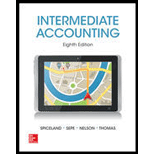
Concept explainers
(1)
Pension expense: Pension expense is an expense to the employer paid as compensation after the completion of services performed by the employees.
Pension expense includes the following components:
- Service cost
- Interest cost
- Expected return on plan assets
- Amortization of prior service cost
- Amortization of net loss or net gain
To compute: The amount of actual return on plan assets
(1)
Explanation of Solution
Calculate the amount of actual return.
(2)
To compute: The loss or gain on plan assets
(2)
Explanation of Solution
Compute the loss or gain on plan assets.
Step 1: Compute the expected returns.
Step 2: Compute the loss or gain on plan assets (Refer to Equations (1) and (2) for both the values).
(3)
To compute: The service cost.
(3)
Explanation of Solution
Compute the service cost.
Step 1: Compute the interest cost.
Step 2: Compute the service cost (Refer to Equation (3) for interest cost value).
(4)
To compute: The pension expense
(4)
Explanation of Solution
The following table shows pension expense.
| Particulars | Amount ($) |
| Service Cost | $310,000 |
| Interest cost | 161,000 |
| Expected return on plan assets | (240,000) |
| Amortization of Prior Service Cost - AOCI | 25,000 |
| Amortization of net gain | 6,000 |
| Pension Expense | $250,000 |
Table (1)
Working Note:
Refer to Requirement (3) for service cost, Equation (3) for interest cost, and Equation (2) for expected return on plan assets value.
Compute the amount of Amortization of Prior Service Cost – AOCI.
Compute the Amortization of Net Gain –AOCI.
| Amortization of Net Gain –AOCI: | |
| Beginning Balance | $330,000 |
| Less: | |
| Ending Balance | (300,000) |
| Loss on Plan Assets | (24,000) |
| Net Gain – AOCI Amortization | $6,000 |
Table (2)
(5)
To compute: The average remaining service life of active employees.
(5)
Explanation of Solution
Compute the average service period.
Working Note:
Refer to Table (2) for Net Gain amount amortized.
Calculate the amount of Net Gain to be amortized.
| Details | Amount ($) |
| Net Gain, Beginning | $330,000 |
| 10% of $2,400,000 | 240,000 |
| Amount to be Amortized | $90,000 |
Table (3)
Want to see more full solutions like this?
Chapter 17 Solutions
Intermediate Accounting w/ Annual Report; Connect Access Card
- I am searching for the most suitable approach to this financial accounting problem with valid standards.arrow_forwardOmega Retail had accounts receivable of $450,000 at year-end. Based on historical data, the company estimates that 3% of accounts receivable will be uncollectible. The Allowance for Doubtful Accounts had a credit balance of $2,800 before adjustment. Calculate the required bad debt expense for the year.arrow_forwardCan you solve this general accounting problem with appropriate steps and explanations?arrow_forward
- I am trying to find the accurate solution to this general accounting problem with the correct explanation.arrow_forwardI need the correct answer to this general accounting problem using the standard accounting approach.arrow_forwardCan you explain the process for solving this financial accounting question accurately?arrow_forward
- Please provide the correct answer to this general accounting problem using accurate calculations.arrow_forwardPlease provide the answer to this general accounting question with proper steps.arrow_forwardCan you solve this general accounting question with the appropriate accounting analysis techniques?arrow_forward

 AccountingAccountingISBN:9781337272094Author:WARREN, Carl S., Reeve, James M., Duchac, Jonathan E.Publisher:Cengage Learning,
AccountingAccountingISBN:9781337272094Author:WARREN, Carl S., Reeve, James M., Duchac, Jonathan E.Publisher:Cengage Learning, Accounting Information SystemsAccountingISBN:9781337619202Author:Hall, James A.Publisher:Cengage Learning,
Accounting Information SystemsAccountingISBN:9781337619202Author:Hall, James A.Publisher:Cengage Learning, Horngren's Cost Accounting: A Managerial Emphasis...AccountingISBN:9780134475585Author:Srikant M. Datar, Madhav V. RajanPublisher:PEARSON
Horngren's Cost Accounting: A Managerial Emphasis...AccountingISBN:9780134475585Author:Srikant M. Datar, Madhav V. RajanPublisher:PEARSON Intermediate AccountingAccountingISBN:9781259722660Author:J. David Spiceland, Mark W. Nelson, Wayne M ThomasPublisher:McGraw-Hill Education
Intermediate AccountingAccountingISBN:9781259722660Author:J. David Spiceland, Mark W. Nelson, Wayne M ThomasPublisher:McGraw-Hill Education Financial and Managerial AccountingAccountingISBN:9781259726705Author:John J Wild, Ken W. Shaw, Barbara Chiappetta Fundamental Accounting PrinciplesPublisher:McGraw-Hill Education
Financial and Managerial AccountingAccountingISBN:9781259726705Author:John J Wild, Ken W. Shaw, Barbara Chiappetta Fundamental Accounting PrinciplesPublisher:McGraw-Hill Education





